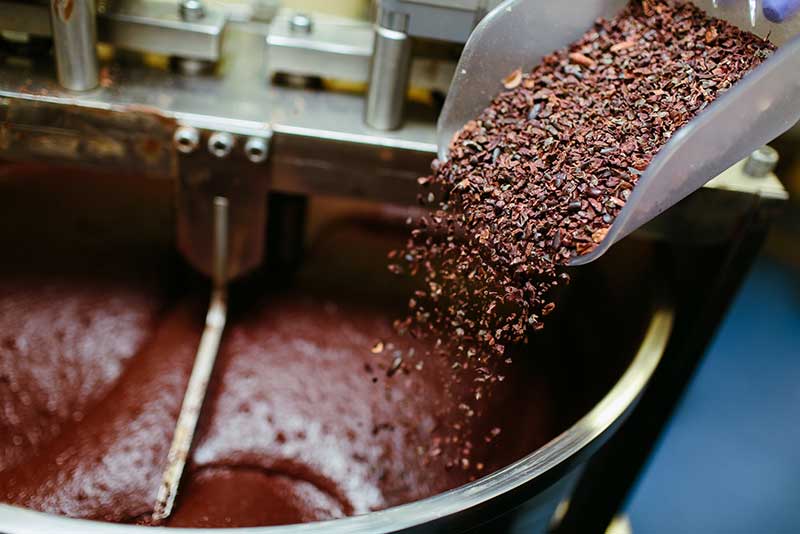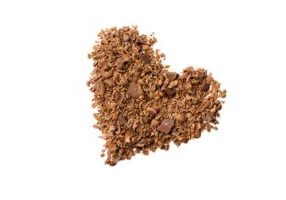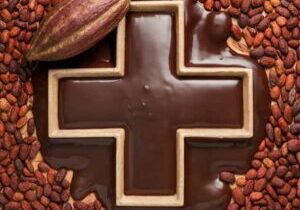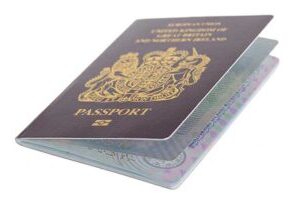BLOG
The Art of Refinement: The History of the Chocolate Conche
Chocolate conching, the process of mixing and aerating liquid chocolate at controlled temperatures, is a crucial step in modern bean-to-bar chocolate making.
This technique, invented by Rodolphe Lindt in 1879, transformed the world of chocolate by creating the smooth, melt-in-your-mouth texture we know and love today.
We have already looked at the science of bean to bar chocolate conching; in this article, we take a look at the fascinating history of the chocolate conche and explore its impact on the chocolate we enjoy today.
How Ancient Civilizations Laid the Foundation for Smooth Chocolate
Long before the invention of the conching machine, ancient Mesoamerican civilizations, such as the Olmecs, Azteks, and Mayans, consumed chocolate as a drink. They would roast and grind cocoa beans on a metate, a curved stone slab with a cylindrical grinding stone called a mano.
This manual grinding process helped develop the flavour and break down the cocoa solids, paving the way for modern refining techniques.
As cocoa beans made their way to Europe in the 1500s, chocolate remained an exclusive drink for the wealthy. Cocoa beans were roasted and ground by hand using heated stones or a mortar and pestle. The ground cocoa was then mixed with sugar and spices and heated to create decadent hot chocolate beverages.
The Industrial Revolution and Chocolate Production
The 19th century brought significant advancements in chocolate production. In 1828, Dutch chemist Coenraad van Houten invented the cocoa press, which squeezed out cocoa butter, leaving behind a cake that could be pulverized into cocoa powder. This innovation made chocolate more homogenous and reduced its bitterness, setting the stage for the creation of solid chocolate.
In 1847, British chocolate maker J.S. Fry & Sons created the first solid chocolate bar by mixing cocoa butter back into Dutch cocoa. While this was a groundbreaking achievement, the resulting chocolate was still gritty and not very palatable by today’s standards.
Lindt’s Lucky Break: Conching Up a Smooth Success

The chocolate world was forever changed in 1879 when Swiss chocolatier Rodolphe Lindt accidentally invented the conching machine.
Legend has it that Lindt left his mixing machine running over a weekend, and upon his return, he discovered that the chocolate inside had transformed into a smooth, mellow substance.
Lindt’s conching machine, a longitudinal agitator that evenly distributed cocoa butter and other ingredients into the chocolate, revolutionized the texture and flavour of chocolate. This process produced chocolate with a superior aroma and mouthfeel, setting a new standard for the industry.
The Science Behind Conching
Conching plays a vital role in refining chocolate’s texture and flavour. The conching process involves mixing and aerating liquid chocolate at controlled temperatures for an extended period, typically 18-72 hours. This process breaks down volatile acids, removes excess moisture, and mellows the bitterness and acidity of the chocolate.
During conching, a series of chemical processes occur, such as oxidation and Maillard reactions, which drive off unwanted flavours while developing desirable ones. The temperature at which the chocolate is conched also plays a significant role in the final product. Lower temperatures around 120°F (49°C) produce more delicate flavours, while higher temperatures up to 180°F (82°C) accelerate flavour development.
Modern Conching Techniques and Equipment
Since Lindt’s original invention, conching technology has advanced significantly. Today’s conching machines are much larger and more sophisticated, capable of processing vast quantities of chocolate with precision and consistency. However, the basic principle remains the same – patient mixing and aerating to develop chocolate’s optimal flavour and mouthfeel.
In the world of bean-to-bar chocolate making, conching remains an essential step for both craft chocolate makers and industrial producers. The bean-to-bar process involves transforming cocoa beans into finished chocolate, with conching playing a crucial role in refining the chocolate’s texture and flavour after the initial grinding of the cocoa nibs.
Conching’s Role in the Artisanal Chocolate Movement
The rise of artisanal and craft chocolate makers in recent years has brought renewed attention to the importance of conching. These passionate chocolate makes often conch their chocolate for longer periods, sometimes up to 72 hours or more, to create the smoothest, most flavourful chocolate possible.
Conching has not only shaped consumer expectations for chocolate texture and flavour but has also become a hallmark of quality in the artisanal chocolate world. Craft chocolate makers take great pride in their conching process, often experimenting with different temperatures, times, and techniques to create unique flavour profiles.
Key Takeaways
- Chocolate conching, invented by Rodolphe Lindt in 1879, is a crucial step in modern bean-to-bar chocolate making that develops chocolate’s smooth texture and refined flavour.
- Ancient Mesoamerican civilizations and early European chocolate makers used manual grinding techniques, laying the foundation for modern chocolate refining.
- The Industrial Revolution brought advancements in chocolate production, including the cocoa press and the first solid chocolate bar.
- Conching involves mixing and aerating liquid chocolate at controlled temperatures, triggering chemical processes that develop desirable flavours and textures.
- Today, conching remains an essential part of the bean-to-bar chocolate making process, with craft chocolate makers and industrial producers alike relying on this technique to create high-quality chocolate.
The history of chocolate conching is a testament to the ingenuity and passion of chocolate makers throughout the ages. From the ancient Mesoamericans grinding cocoa beans on a metate to Rodolphe Lindt’s accidental invention of the conching machine, each step in the journey has contributed to the smooth, decadent chocolate we enjoy today. As artisanal and craft chocolate makers continue to push the boundaries of flavour and texture, the legacy of chocolate conching endures, reminding us of the sweet science and rich history behind every delicious bite.










